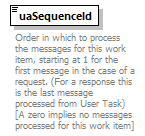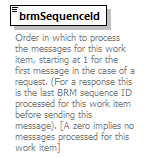| diagram |  |
||
| namespace | http://api.brm.n2.tibco.com | ||
| children | workItemId activityID uaSequenceId brmSequenceId | ||
| annotation |
|
||
| source | <xsd:complexType name="AsyncWorkItemDetails"> <xsd:annotation> <xsd:documentation>Definition of the additional information required for asynchronous work item handling.</xsd:documentation> </xsd:annotation> <xsd:sequence> <xsd:element name="workItemId" type="ObjectID"/> <xsd:element name="activityID" type="xs:string"> <xsd:annotation> <xsd:documentation>Unique identifier for this message, this identifier will match the request and the response</xsd:documentation> </xsd:annotation> </xsd:element> <xsd:element name="uaSequenceId" type="xs:int"> <xsd:annotation> <xsd:documentation>Order in which to process the messages for this work item, starting at 1 for the first message in the case of a request. (For a response this is the last message processed from User Task) [A zero implies no messages processed for this work item]</xsd:documentation> </xsd:annotation> </xsd:element> <xsd:element name="brmSequenceId" type="xs:int"> <xsd:annotation> <xsd:documentation>Order in which to process the messages for this work item, starting at 1 for the first message in the case of a request. (For a response this is the last BRM sequence ID processed for this work item before sending this message). [A zero implies no messages processed for this work item]</xsd:documentation> </xsd:annotation> </xsd:element> </xsd:sequence> </xsd:complexType> |
element AsyncWorkItemDetails/workItemId
| diagram |  |
||||||||||||||
| type | ObjectID | ||||||||||||||
| properties |
|
||||||||||||||
| attributes |
|
||||||||||||||
| source | <xsd:element name="workItemId" type="ObjectID"/> |
element AsyncWorkItemDetails/activityID
| diagram |  |
||
| type | xs:string | ||
| properties |
|
||
| annotation |
|
||
| source | <xsd:element name="activityID" type="xs:string"> <xsd:annotation> <xsd:documentation>Unique identifier for this message, this identifier will match the request and the response</xsd:documentation> </xsd:annotation> </xsd:element> |
element AsyncWorkItemDetails/uaSequenceId
| diagram |  |
||
| type | xs:int | ||
| properties |
|
||
| annotation |
|
||
| source | <xsd:element name="uaSequenceId" type="xs:int"> <xsd:annotation> <xsd:documentation>Order in which to process the messages for this work item, starting at 1 for the first message in the case of a request. (For a response this is the last message processed from User Task) [A zero implies no messages processed for this work item]</xsd:documentation> </xsd:annotation> </xsd:element> |
element AsyncWorkItemDetails/brmSequenceId
| diagram |  |
||
| type | xs:int | ||
| properties |
|
||
| annotation |
|
||
| source | <xsd:element name="brmSequenceId" type="xs:int"> <xsd:annotation> <xsd:documentation>Order in which to process the messages for this work item, starting at 1 for the first message in the case of a request. (For a response this is the last BRM sequence ID processed for this work item before sending this message). [A zero implies no messages processed for this work item]</xsd:documentation> </xsd:annotation> </xsd:element> |
WSDL documentation generated by XMLSpy WSDL Editor http://www.altova.com/xmlspy